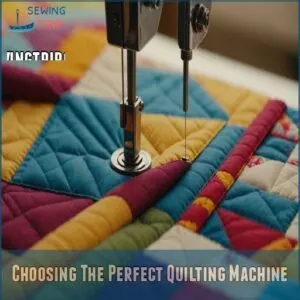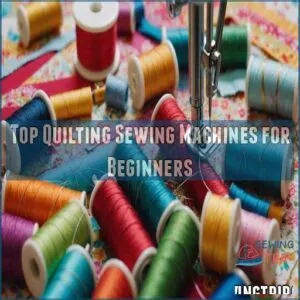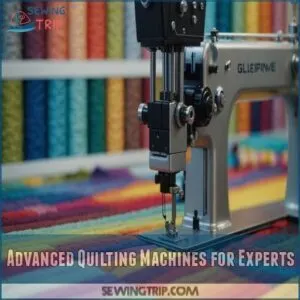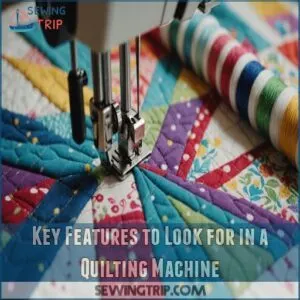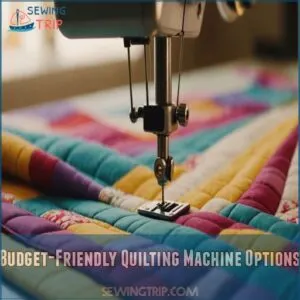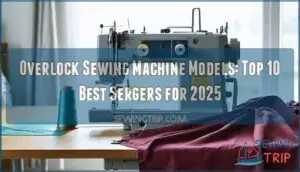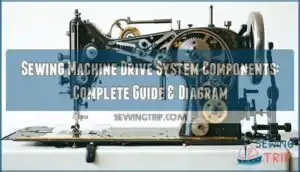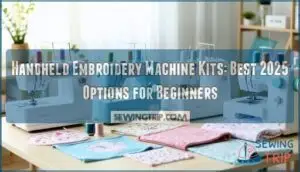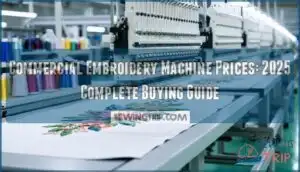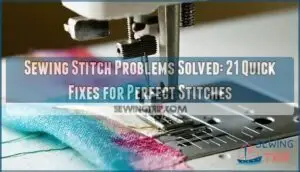This site is supported by our readers. We may earn a commission, at no cost to you, if you purchase through links.
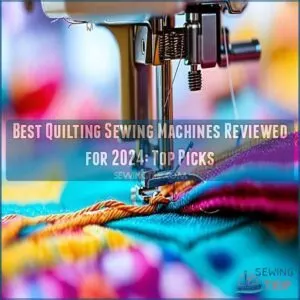 When you’re on the hunt for the best quilting sewing machines, Brother’s PQ1600S and Singer’s 7469Q stand out for beginners, offering speed and simplicity.
When you’re on the hunt for the best quilting sewing machines, Brother’s PQ1600S and Singer’s 7469Q stand out for beginners, offering speed and simplicity.
For seasoned quilters, the Juki TL-2000Qi’s spacious work area and rapid stitching are dream features, while the Bernette B77 dazzles with extensive stitch choices.
Don’t overlook budget-friendly gems like the Brother XR3774, which balances features and affordability.
Whether you’re piecing together your first quilt or tackling intricate patterns, choosing the right machine means matching features to your quilting aspirations.
Want to discover which machine fits your stitching style perfectly? There’s more to explore!
Table Of Contents
Key Takeaways
- You’ll find the perfect quilting machine by considering your budget, skill level, and the size of your projects.
- Beginners should prioritize user-friendly machines with good speed and basic features, while experts should look for advanced stitch options and larger workspaces.
- Essential features include a walking foot for even feeding, a spacious workspace or extension table, and a high sewing speed for efficiency.
- Budget-friendly options exist, but don’t compromise on essential features; research reviews to find the best value for your money.
Choosing The Perfect Quilting Machine
To choose the perfect quilting machine, you’ll need to think about factors like budget, machine features, and types available.
Understanding your specific quilting needs helps you pick a machine that complements and enhances your projects effectively.
Factors to Consider When Buying
When picking the best quilting machine, consider three key factors, including the throat space, stitch variety, and durability, all of which are crucial in choosing the best quilting machine. When picking the best quilting machine, consider three key factors.
Check out quilting machine reviews online for insights, like at quilting machine reviews.
First, think about your budget and how much you’re willing to spend.
Second, focus on the machine features that matter most to you.
Third, examine the warranty and see what protection is offered.
When choosing a quilting sewing machine, consider the key features such as wide throat space and droppable feed dogs for free motion quilting. User reviews and brand reputation also give insights into quilting machine features and reliability.
Types of Quilting Machines Available
As you sift through options, understanding the types of quilting machines is key.
Long-arm machines offer expansive workspaces for large projects.
Basic quilting machines focus on straightforward piecing.
Meanwhile, serger and embroidery machines add unique finishes and intricate designs.
All-in-one machines combine features for ultimate flexibility, making them ideal if you’re aiming for versatility in your quilting endeavors.
Understanding Your Quilting Needs
Selecting an ideal quilting machine becomes easier after grasping your quilting needs.
Consider your quilt size and project complexity—what’s on your quilting horizon?
Let’s break it down:
- Skill level: Make sure the machine aligns with your expertise.
- Budget constraints: Find value without unnecessary splurges.
- Sewing space: Match machine size to your workspace for comfort.
Top Quilting Sewing Machines for Beginners
Choosing your first quilting machine can feel like diving into a sea of options.
To help you find the right fit, consider what’s essential.
Budget-friendly quilting machines offer you a stepping stone into quilting without breaking the bank.
The Brother PQ1600S is a solid favorite for beginners, with high-speed stitching and customizable features.
Meanwhile, the Singer 7469Q offers a smooth introduction with straightforward functions and reliable performance.
Here’s a quick comparison to get you started:
| Model | Key Feature |
|---|---|
| Brother PQ1600S | 1,500 stitches per minute speed |
| Singer 7469Q | User-friendly controls |
| Brother XR3774 | Dual sewing and quilting capabilities |
| Janome 3160QDC | Jam-proof bobbin system |
| Bernette B77 | Versatile stitch options |
These machines make quilting as easy as piecing together your first patchwork quilt.
Advanced Quilting Machines for Experts
Ready to elevate your quilting game? This section explores high-end machines packed with features for experienced quilters, ensuring you find the perfect tool for your intricate projects.
Juki HZL-F600 Advanced Features and Capabilities
Dive deep into the Juki HZL-F600 and discover its advanced quilting capabilities, boasting an impressive 225 built-in stitches and 67 quilting patterns for large projects.
This sewing marvel offers exceptional stitch quality and a user-friendly interface, perfect for expert quilters.
With its extensive accessories and versatile quilting techniques, it truly stands out in quilting machine reviews.
Embrace precision and efficiency as you explore the features that make this machine a favorite for avid quilters.
Bernette B77 Multiple Stitch Options
After exploring Juki’s robust features, let’s look at the Bernette B77.
This model’s stitch library inspires creativity, offering extensive stitch customization for your quilting projects.
Imagine the design potential!
You’ll appreciate its detailed stitch comparison capabilities.
The B77 redefines quilting machine styles and stands out in quilting machine recommendations and ratings, making it a top choice for experts.
Juki TL-2000Qi Long-Arm Quilting Machine Review
With the Juki TL-2000Qi long-arm quilting machine, you’ve hit the jackpot for precise crafting.
This powerhouse excels with 1,500 stitches per minute, offering speed for demanding quilters, and can be a valuable addition to your collection when shopping for top quilting machines online at advanced quilting supplies.
Its generous workspace makes large quilting projects a breeze.
Compare Juki vs. Janome, and you’ll find Juki’s robust build and smooth operation perfect for expert projects.
Add this gem to your creative toolbox.
Key Features to Look for in a Quilting Machine
When you’re choosing a quilting machine, prioritize features like a spacious workspace and an extension table for easy handling of large quilts.
Spacious workspace and extension table are essential for handling large quilts with ease.
Look for capabilities like walking feet for fabric precision, high sewing speeds for efficiency, and a variety of stitch options to customize your projects.
Workspace and Extension Table Importance
Large projects like quilts demand ample space.
That’s where the workspace and extension table step in, boosting your quilting machine’s capabilities.
A generous table supports quilt size management and combats space limitations, and you can find the best quilting machines with large workspaces by checking out top-rated sewing machine quilting options online best sewing machines.
It guarantees table stability, guaranteeing quilting ease and stitching precision.
Investing in these features provides quilting machine advice that’s invaluable—you’re heading for smooth, professional results effortlessly!
Walking Foot and Sewing Speed Benefits
When you’re quilting, the walking foot and sewing speed can transform your experience.
They’re not just bells and whistles; they make quilting smoother and faster.
- Reliable stitching on thick fabrics.
- Effortless handling of large quilts.
- Consistent fabric feeding for neat stitches.
- Quicker project completion, upping your productivity.
Harness these features for precision and efficiency in every stitch.
Number of Stitches and Customization Options
Seriously, stitch count matters!
A higher stitch count means more options for decorative stitches.
Consider stitch width and length adjustments for precise control.
Many machines offer custom stitch patterns, expanding your quilting machine designs.
Explore quilting machine resources; a good quilting machine guide helps you discover the full potential of your machine.
Don’t underestimate the impact of stitch customization on your projects!
Budget-Friendly Quilting Machine Options
You’re on the hunt for a quilting machine that combines affordability with performance, and you don’t want to break the bank.
Consider the Brother XR3774, Singer 7469Q Confidence Quilter, and Janome 3160QDC, each offering great features at budget-friendly prices.
Brother XR3774 Budget-Friendly Features
After considering key features, the Brother XR3774 stands out for those on a budget.
With 37 built-in stitches and an easy needle threader, it’s both practical and approachable.
The best computerized sewing machines for quilting, such as those offering quilting automation software, provide a high-tech advantage over mechanical machines. The drop-in top bobbin and its dual capabilities for sewing and quilting highlight its top features.
User reviews mention it as a reliable alternative to more expensive models.
Singer 7469Q Confidence Quilter Affordable Price
You might ask if a budget-friendly quilting machine really delivers.
The Singer 7469Q Confidence Quilter answers with its twin needle sewing capability and drop-and-sew bobbin system, making projects a breeze.
User reviews highlight its affordable price without sacrificing essential features.
Comparing pros and cons, its versatility stands out, inspiring quilting enthusiasts looking to explore creative projects on a budget.
Janome 3160QDC Value for Money
When considering budget-friendly quilting machines, the Janome 3160QDC offers excellent value for money.
Its features include:
- Jam-proof bobbin system ensuring effortless sewing
- Thread cutter button for increased efficiency
- User-friendly LCD display simplifying controls
- Lightweight design making it portable
This machine is praised in user reviews, standing out in features comparison and beginners’ guides.
Quilting machine tutorials reinforce its appeal.
Frequently Asked Questions (FAQs)
What is the best sewing machine for quilting?
The best quilting machine depends on your skill and budget. Consider features like throat space, speed, and drop-down feed dogs. Research top brands like Juki and Brother for reliable options.
Which sewing machine should I buy?
Variety’s the spice of sewing.
Choose Juki HZL-F600 for versatility or Brother XR3774 for budget-friendly projects.
Consider workspace size, speed, and desired features like built-in stitches and needle threading to find the perfect fit for your quilting needs.
Which Brother Sewing Machine is best for quilting?
You might find the Brother HC1850 ideal for quilting with its 185 built-in stitches, wide table, and advanced needle threader, especially when considering quilting machine features.
It’s flexible, offering various stitch options, and user-friendly, ensuring a smooth quilting experience.
What is the best automatic controlled sewing machine for quilting?
Imagine a quilting machine as a maestro orchestrating a symphony, where precision counts.
The Juki HZL-F600 shines with 255 built-in stitches, an intuitive LCD screen, reliable automatic controls, and accessories, balancing complexity and ease.
What brand is the quilters choice sewing machine?
Quilters often look for sewing machines with a user-friendly interface and a variety of built-in stitches, such as the best Janome sewing machine, which offers features suitable for quilting and heavy-duty projects. Quilters Choice sewing machines are often associated with the brand Janome.
Janome is known for quality and innovation.
Janome offers a range of machines that cater to both beginner and professional quilters, making them a popular choice among enthusiasts.
Which sewing machine has the least problems?
When reliability’s your top concern, the Juki TL-2000Qi sewing machine often tops the list.
Known for its sturdy build and minimal issues, this machine’s ideal for both professionals and hobbyists seeking consistency in their projects.
What quilting machine does Angela Walters use?
Angela Walters, a well-known quilter, often chooses machines like BERNINA longarm quilters for precise engineering and innovative features. Angela Walters, a well-known quilter, often uses the Handi Quilter longarm quilting machines, such as the HQ Avante or HQ Fusion.
These machines are designed for precision quilting, offering features that suit her artistic needs.
What is the most dependable sewing machine?
The "most" dependable machine’s subjective; it depends on your needs. Consider features like stitch quality, durability, and ease of use. Read reviews before you buy!
How do I maintain my quilting machine?
Regularly clean your quilting machine by removing lint with a soft brush, oil key parts specified in the manual, and adjust tension settings as needed.
Change needles often to prevent fabric damage, ensuring smooth, flawless quilting projects.
What accessories enhance quilting efficiency?
Did you know quilters save about 15% quilting time with proper accessories?
Use a walking foot for even stitching, a quarter-inch seam foot for precise seams, and extension tables to enhance workspace and maneuverability.
How often should quilting machines be serviced?
You should service your quilting machine every six to twelve months if you’re a frequent user.
Regular maintenance helps the machine run smoothly, preventing thread jams and extending the machine’s life.
Always refer to your machine’s manual for specific guidance.
Can quilting machines handle heavy fabrics?
Most quilting machines can handle heavy fabrics like denim or canvas due to their powerful motors and sturdy builds.
Make sure your machine includes a walking foot and adjustable presser foot pressure to tackle those tough materials smoothly.
Are quilting machines environmentally friendly?
Quilting machines aren’t as green as you’d dream, but some models minimize footprints.
Look for energy-efficient features, durable materials, and options that support eco-friendly practices like recycling fabric scraps, ensuring your creative endeavors don’t harm the earth.
Conclusion
Picture Sarah, a quilting enthusiast who starts her journey with the user-friendly Brother XR3774 and later masters intricate patterns using the advanced Bernette B77.
Like Sarah, choosing from the best quilting sewing machines reviewed means finding the right match for your skills and projects.
Consider workspace, stitch options, and budget to make an informed choice.
Whether you’re just starting or an expert quilter, the perfect machine elevates your craft and fuels your creativity.

